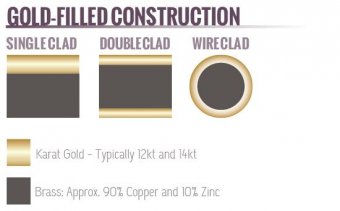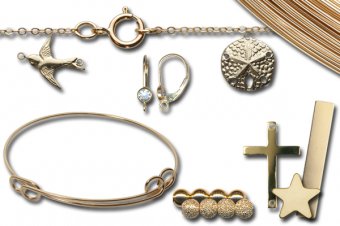
 Watch our Halstead Jewelry Minute Gold-filled 101 video for detailed information on gold-filled material construction, gold layer alloy components and more. The video has different content than the text below so be sure to check it out!
Watch our Halstead Jewelry Minute Gold-filled 101 video for detailed information on gold-filled material construction, gold layer alloy components and more. The video has different content than the text below so be sure to check it out!
A lot of new jewelers have some misconceptions about gold-filled jewelry supplies. If you are selling gold-filled items it is important to understand the product so you can accurately describe it to customers and handle it properly. Here are five common questions we get about gold-filled. But, first a little bit of information about the material.
Gold-filled is constructed in two or three layers. The core metal is jewelers’ brass. Single clad gold-filled has all the gold content in a single layer on one side. Double clad gold-filled splits the gold content into surface layers on both sides of the material. The gold alloy is then bonded to one or both surfaces of the brass core with heat and pressure. The bonded raw material is then sold as sheet or wire to jewelry manufacturers for use in designs.
Gold-filled is legally required to contain 5% or 1/20 gold by weight. This 5% is then described by the karatage of the gold alloy. Most gold-filled is 12kt or 14kt gold-filled. It is most accurately labeled with the karatage, the “/” symbol, and then 20 to reflect this construction. Products are identified as 14/20 Gold-filled or 12/20 Gold-Filled; alternatively, 14kt Gold-Filled or 12kt Gold-Filled are also acceptable.
1. Why can’t you stock more of your cast charms in gold-filled?
Gold-filled cannot be cast. This is a major limitation in the types of products that can be manufactured in gold-filled. Products must be made from sheet, tube or wire that retain the layers constructed in brass and gold. Casting by definition is melting the metal material which would alloy the layers into one big melted mess.
2. Why don’t you stock gold-filled solder?
First, there is no such thing as gold-filled solder. Second, we do not recommend soldering gold-filled without specific equipment and specialized training on gold-filled soldering. If you attempt to solder gold-filled with a torch and normal gold or brazing solder you will burn off the gold surface layer of gold-filled and leave a dark brass solder joint that will be markedly different than the neighboring gold. The exposed brass joint will quickly tarnish to black and be even more distinct. The only way to repair it at this point is to plate the entire item in gold to cover the joint and match color all over the piece. We do not recommend soldering gold-filled items. Nor do we recommend sanding gold-filled since you are removing just the gold portion of the product and decreasing the surface layer integrity.
 3. I need the gold item XYZ…
3. I need the gold item XYZ…
OK, this one isn’t a question but it raises an important issue. Some jewelry designers will refer to gold-filled items as just “gold.” It is not gold and it is illegal to call gold-filled items gold, which implies they are a solid alloy with much higher pure gold content. Gold-filled is a unique material and must be clearly distinguished from solid gold by professionals in the industry. “Gold” is not an acceptable short hand and it can get you in legal trouble for fraud. Don’t get in this bad habit.
4. Is gold-filled the same as gold plate?
No, gold plating is a miniscule layer of solid gold applied to a brass base. The plating does not compose any measurable proportion of the product’s total weight. It is estimated to be 0.05% or less of the metal product. Gold plating will wear off rather quickly and expose the brass base product. It does not stand up to heat, water or wear over time. By comparison, gold-filled contains 5% gold by weight; moreover, all the gold is on the surface which offers product protection from tarnish and wear.
5. Can gold-filled tarnish?
Yes it can, but it takes a rare set of circumstances. Gold-filled is usually a lifetime product because the gold layer bonded to the brass core is quite thick. However, in rare instances of extreme sulfide exposure the gold-filled can blacken. This has only occurred a handful of times over our decades of gold-filled use. Foreign transit through extremely polluted shipping docks in a few countries has caused the product to blacken on several occasions. The only domestic cases we have had were products stored in nail salons with high levels of chemical sulfide fumes and due to a fire where the structure was filled with smoke and all the gold-filled in the building turned black. These are extreme conditions that are unlikely to happen to most end users. However, it has made me think twice about breathing the air in nail salons. Usually, gold filled just requires light surface cleaning with an untreated cloth or mild soapy water.
Gold-filled is a reasonably priced, quality alternative to solid gold. Most gold-filled items are made in the USA. We offer a wide selection of gold filled chain, charms and findings to outfit your jewelry studio with plenty of materials for gold-filled jewelry design.








